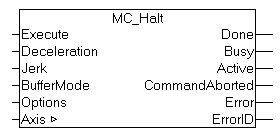MC_Halt

MC_Halt stops an axis with a defined braking ramp.
In contrast to MC_Stop, the axis is not locked against further movement commands. The axis can therefore be restarted through a further command during the braking ramp or after it has come to a halt.
Travel commands can be applied to coupled slave axes, if this option was explicitly activated in the axis parameters. A motion command such as MC_Halt then automatically leads to uncoupling of the axis, after which the command is executed. In this case only Buffer-ModeAborting is possible.
Inputs
VAR_INPUT
Execute : BOOL;
Deceleration : LREAL;
Jerk : LREAL;
BufferMode : MC_BufferMode;
Options : ST_MoveOptions;
END_VAR
|
Execute |
The command is executed with a rising edge at input Execute. |
|
Deceleration |
Deceleration (≥0). If the value is 0, the deceleration parameterized with the last Move command is used. |
|
Jerk |
Jerk (≥0). If the value is 0, the jerk parameterized with the last Move command is used. |
|
BufferMode |
The BufferMode is analyzed, if the axis is already executing another command. The running command can be aborted, or the new command becomes active after the running command. The BufferMode also determines the transition condition from the current to the next command. |
|
Options |
Currently not implemented - The data structure option includes additional, rarely required parameters. The input can normally remain open. |
Outputs
VAR_OUTPUT
Done : BOOL;
Busy : BOOL;
Active : BOOL;
CommandAborted : BOOL;
Error : BOOL;
ErrorID : UDINT;
END_VAR
|
Done |
The Done output becomes TRUE, if the axis was stopped and has come to a standstill. |
|
Busy |
The Busy output becomes TRUE when the command is started with Execute and remains TRUE as long as the command is processed. If Busy becomes FALSE again, the function block is ready for a new job. At the same time one of the outputs, Done, CommandAborted or Error, is set. |
|
Active |
Active indicates that the command is executed If the command was queued, it becomes active once a running command is completed. |
|
CommandAborted |
Becomes TRUE, if the command could not be fully executed. The running command may have been followed by a Move command. |
|
Error |
Becomes TRUE if an error occurs. |
|
ErrorID |
If the error output is set, this parameter supplies the error number. |